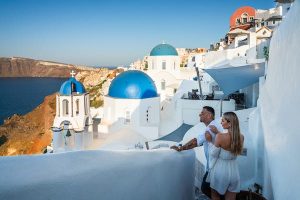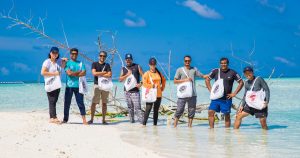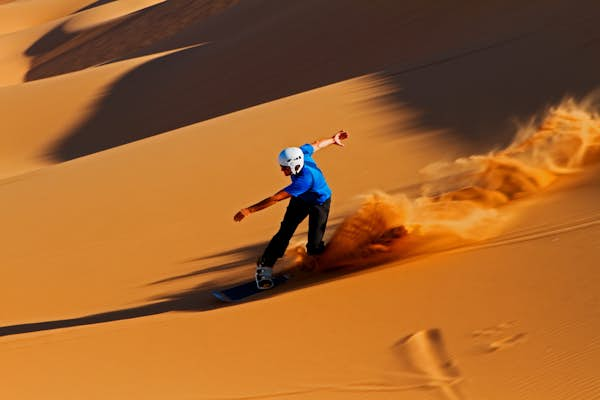
Ocean and desert collide in Namibia to provide adventure playgrounds of water, sand and rock, with each as vast (and wild) as the other.
Namibia’s landscapes are epic, both in terms of sheer scale and natural beauty. Imagine singing sands and dunes that climb to more than 300m (985ft) in height and look more like works of art by Gaudí than anything produced by blowing winds. Now picture yourself hiking across their undulating crests and looking across an ocean of mammoth waves frozen in sand. If you feel like boarding down one of those waves, that’s an option too.
Explore the planet’s most surprising adventures with our weekly newsletter delivered to your inbox.
But the Namib Desert, which gave the country its name, is more than just a huge sandbox. It’s also tortured mountains and rocky canyons. These captivating environments are ripe for explorations on foot or mountain bike.
Soaring inselbergs such as Spitzkoppe are great places to cling to if you have a penchant for rock climbing. Flanking the entire country’s west, running almost 1600km (994 miles) from South Africa to Angola, is a wild coastline with a history of sinking ships (it was these wrecks, plus sands littered with whale and seal bones, that gave the Skeleton Coast its name). But with a surfboard in hand, you’ll find nothing but joy along these remote shores.
Namibia: a playground for sure.
Dune boarding
The Namib is arguably the world’s oldest desert, but there’s a new way to experience its dunes: on a board. Not far from Namibia’s coastal town of Swakopmund, one of southern Africa’s capitals for adventure activities, mountains of sand provide perfect slopes to carve down.
When you first set eyes on the dunes rising high into the blue African sky, you’ll begin to buzz with anticipation, though it’s wise to conserve a little energy. Your journey of joy starts with some hard work: a hike up to your launching point. With board, gloves and goggles in hand, you’re eventually staring down over some serious off-piste action. Strap in, lean further back than you’re used to (if you’re familiar with snowboarding) and let loose!
Once you’ve had your fill, try the lie-down “schuss” option, which will see you hit speeds of 80km/h (50 mph). Alter Action runs daily dune boarding trips from Swakopmund.
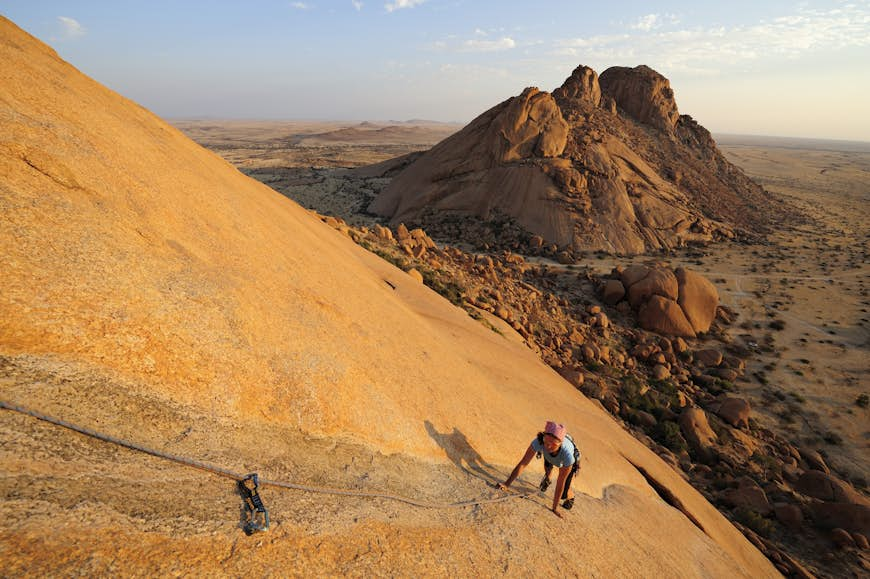 Spitzkoppe, the “Matterhorn of Africa,” offers routes and pitches for climbers of all abilities © Andreas Strauss / Getty Images
Spitzkoppe, the “Matterhorn of Africa,” offers routes and pitches for climbers of all abilities © Andreas Strauss / Getty Images
Rock climbing
Rising like a mirage above the desert plains of southern Damaraland, the behemoth 1728m-high inselberg that is Spitzkoppe has long inspired climbers and earned it the moniker “Matterhorn of Africa.” Although first summited in 1946, its granite flanks continue to call out to hardcore climbers bent on tackling the nation’s most challenging peak.
Some of the lower, rounded domes offer thrilling scrambling for those who aren’t as keen to tackle the vertical pitches. At night, camp below it all for a celestial show like no other.
Skydiving
Seeing the large swells of the cold southern Atlantic Ocean crashing into the delicate-looking desert dunes is compelling from wherever you’re standing. Seeing it while falling toward earth at 220km/h (137 mph) is mind-blowing. The incredible aerial views of the desert landscape and ocean during the 25-minute flight up to the jump zone in a tiny Cessna aircraft are reason enough for the trip (and price tag).
The deafeningly exciting free fall from 3000m (9843ft) lasts for approximately 30 seconds before your parachute (and silence) takes over at 1500m (4921ft). Swakopmund-based Ground Rush Adventures offers tandem jumps for beginners, as well as static-line courses and jumps, and accelerated free-fall courses.
Discover Namibia’s Skeleton Coast
Kitesurfing
Harnessing the power of the winds along the Atlantic coast with a large kite is a thrilling challenge, whether on land or water. Novices can first learn the ropes (literally) with power kiting lessons, while those with the skills can take on kitesurfing courses (international levels 1-3) in the Atlantic or basic landboarding lessons on the Namib’s sands. Paragliding courses along this section of the coast are also on the horizon.
 Namibia is like the mountain biking haven of Moab, Utah, without the crowds © Douglas Holder / Getty Images
Namibia is like the mountain biking haven of Moab, Utah, without the crowds © Douglas Holder / Getty Images
Mountain biking
Imagine Moab, Utah. Amazing, right? Now imagine it sitting empty. Welcome to Namibia! Not only is there a profusion of compelling trails and dramatic scenery – rollercoaster singletracks through the moonscapes outside of Swakopmund, tricky jeep routes around the dry riverbed of the Huab and memorable descents down the Auas Mountains – but you can also spy incredible African wildlife from your saddle, such as rare desert-adapted elephant and black rhino.
With almost no vehicular traffic on the country’s graded gravel roads, multiday mountain bike expeditions are a fantastic option. A good place to start is Klein Aus Vista near Aus in southern Namibia.
Hot air ballooning
The almost 50,000-sq-km (19,305-sq-mile) Namib-Naukluft National Park is home to some of the most spectacular dunes on the planet, particularly in the area around Sossusvlei. The winds have shaped the bright orangey-red sands into elegant parabolic shapes hundreds of meters high. Viewing this unique desert landscape from the air is a spellbinding experience, and early morning balloon rides are possible.
Namib Sky Balloon Safaris operate the trips every morning at sunrise, weather permitting (trips don’t run from January 15 to February 15 because of heat). Pickups can be arranged from several accommodation options in the Sossusvlei/Sesriem area. Flights include a champagne breakfast upon landing.
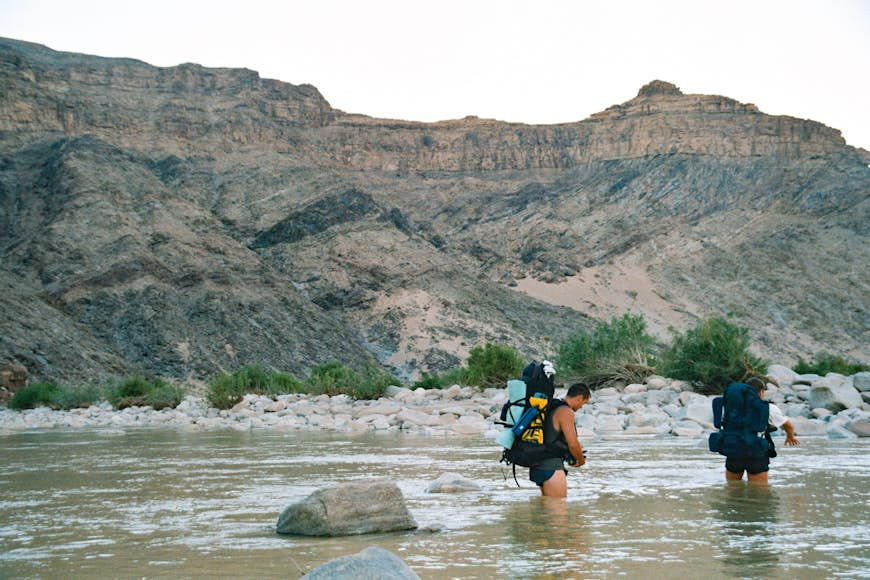 The Fish River Canyon is one of the world’s largest, and it’s a great place for multiday hikes in the cooler months © wilpunt / Getty Images
The Fish River Canyon is one of the world’s largest, and it’s a great place for multiday hikes in the cooler months © wilpunt / Getty Images
Hiking
Between hard rocks or atop a soft place, hiking in Namibia offers adventurous extremes. These can vary from short explorations of large dune fields – most spectacularly around Sossusvlei in Namib-Naukluft National Park – to more serious endeavors such as the five-day trek through the rocky depths of one of the world’s largest canyons.
Because of soaring summer temperatures and the remoteness of the Fish River Canyon floor, hikes in the latter are restricted to May through mid-September. The enchanting and incredibly challenging 85km (53-mile) route from Hobas to Ai-Ais follows the sandy riverbed past huge boulder fields, startlingly dramatic scenery and a series of ephemeral pools (perfect for dips to beat the heat).
Other notable hikes include four- and eight-day loops through the Naukluft Mountains, which offer a more subtle charm than the Fish River Canyon. Speaking of “note-able,” it’s possible to make the ground beneath you sing (well, hum) – usually in notes E, F or G – while hiking the crests of dunes south of Swakopmund or north along the Skeleton Coast. The unique mineral composition of Namib’s sand in these areas causes it to loudly resonate when disturbed.
How to choose an epic hike on any continent in the world
 Plenty of remote breaks make surfing in Namibia very enjoyable © Siempreverde22 / iStockphoto
Plenty of remote breaks make surfing in Namibia very enjoyable © Siempreverde22 / iStockphoto
Surfing
With nothing standing between Brazil and the coast of Namibia, there is no shortage of large south Atlantic swell to rip it up on. Sharks, seals, sand storms and incredibly remote breaks mean there’s certainly no shortage of adventure either. A great place to get your feet wet is in the coastal town of Swakopmund. The waves of choice are at Nordstrand near Vineta Point – an exposed reef break that is particularly good at high tide when the swell angle is from the west-southwest.
Tiger Reef, at the mouth of the Swakop River, is another solid option. There’s an exceptionally long left-hand point break at Bocock’s Bay, a remote spot some 160km (99 miles) north of Swakopmund. The surf here, formed over a soft sandbank, is incredibly consistent, and you’ll likely have it all to yourself. Cape Cross, 30km (19 miles) south of here, has some sweet waves too, though you’ll be sharing the water with tens of thousands of seals.
April and May tend to be the best months for surfing in Namibia, though any time between March and October is rewarding. Shark numbers boom in the off-season when most mating occurs.


